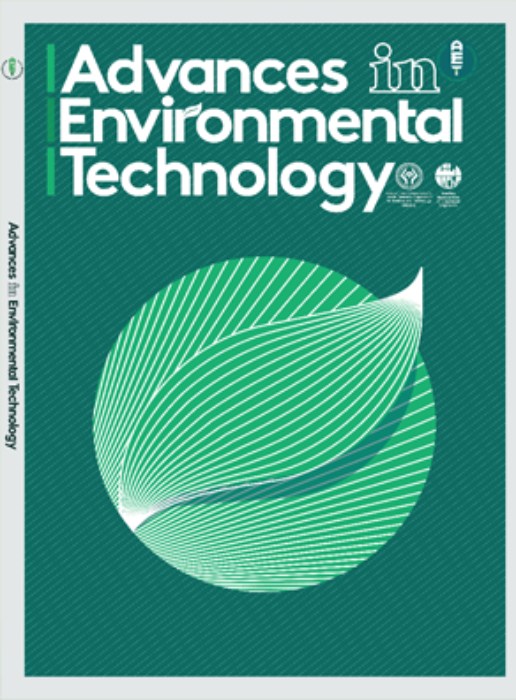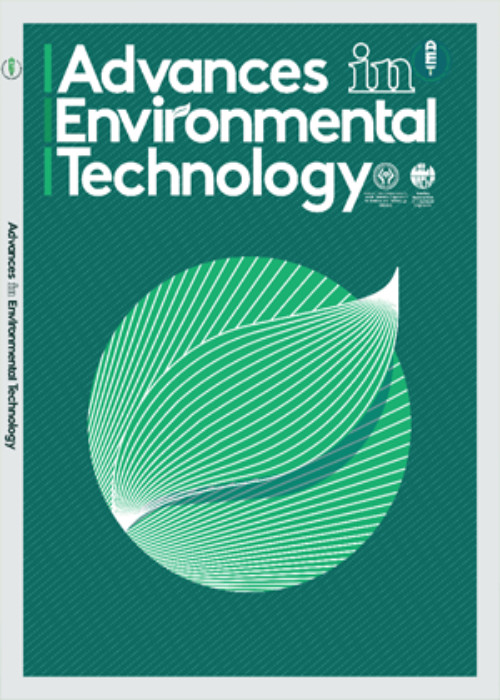فهرست مطالب

Advances in Environmental Technology
Volume:8 Issue: 4, Autumn 2022
- تاریخ انتشار: 1401/10/04
- تعداد عناوین: 6
-
-
Pages 255-270The present work investigates the aeration pressurization effect by monitoring the airflow (Qg) variations during its injection at various diffuser arrangements in an activated sludge (AS) system and its impact on the overall energy-saving strategy. To this extent, a laboratory pilot-scale system (450 mm in length, 400 mm in width, and 470 mm high) was built to conduct the experiments with an effective volume of 84.6 L. To determine the optimum operating conditions, an experimental design combined with the grey method was used to establish the optimal tests to minimize the process’s energy footprint based on the pressurization effect due to various diffuser arrangements. Successful implementation of this operation confirmed that controlling the local diffuser densities (DDL) benefits the power consumption value by experiment ( ) savings and the mixing performances at a DDL = 0.0144. Undoubtedly, increasing the DDL improved the mixing performance of the AS and reduced the inhibition of the oxygen mass transfer coefficient by the mixed liquor suspended solids (MLSS). Furthermore, an empirical model was built to describe the nature of the power consumed accurately. The outcomes showed that the coefficient of determination was R² = 0.9856 with a significant corresponding probability (P-values) < 0.05. As a result, the multiple linear regression model (MLR), which means that the model’s reliability to predict the data revealed an R² > 80 %, confirmed that the model is reliable at a 95% confidence interval (CI).Keywords: Optimization, Wastewater, Modeling, Diffuser, Aeration
-
Pages 271-278Penicillin is one of the emerging pollutants that has toxic effects on food chains and aquatic environments. It creates many problems for human health and other living organisms. Conventional wastewater treatment methods cannot remove penicillin; therefore, modern approaches are necessary to remove it from sewage. In this study, we examined the ability of TiO2 photocatalysis in the degradation of penicillin in aqueous solutions. The effects of different factors such as adsorption, pH, catalyst dosage, the initial concentration of penicillin, and time were examined. The results showed that photolysis and adsorption had negligible effects on penicillin degradation. The maximum degradation (94.5%) was observed at an ambient pH of 5, 0.1 g/l of TiO2, and 20 mg/l of penicillin for 90 min. The photodegradation of penicillin followed a first-order kinetic reaction, and the rate constant (k) was 0.0213 min-1. A TOC analysis was conducted to determine the fate of the pollutant. The results showed that 41% of the organic carbon was removed in 120 min. Based on the results, TiO2 photocatalysis is an economically feasible procedure with good efficiency in removing penicillin from the aquatic environment.Keywords: Catalyst, pharmaceutical pollution, penicillin, Photodegradation, Titanium dioxide
-
Pages 279-292The current study focused on the charge and mass transport effect on the continuous electro-Fenton (EF) process treatment of synthetic Reactive orange 16 (RO16) dye using low-cost stainless-steel electrodes and sodium chloride (NaCl) supporting electrolytes, respectively. Lab-scale experiments were carried out in a 500 mL volume reactor cell at various initial RO16 dye concentrations (75-250 mg/L) and flow rates (0.05-0.4 L/h). The results showed that the decolorization rate increased quantitatively with an increment of the RO16 dye concentration and flow rate due to the mass transport limitation. Increasing the mass flow rate increased the mass transfer coefficient (km), improving the kinetics of the decay. It was found that regardless of inflow concentrations, the dye removal efficiency increased with the flow rate. Additionally, the degradation rate, elimination capacity, current efficiency (CE), and specific energy requirement were estimated for the process. A dimensionless current density relation was generated for the developed continuous stirred tank to describe the kinetics and mass transfer relationship towards the overall reaction rate contribution. It was found that the stainless-steel anode electrode proved to be preferable due to lower energy consumption (6.5 kWh m-3) and less iron sludge production. Additionally, the application of pyrite (FeS2) particulate electrode increased the process efficiency (~ 5%) for TOC removal and current mineralization while maintaining its sustainability for reuse.Keywords: Reactive Orange 16, Continuous electro-Fenton process, Mass transport, Pyrite particulate electrode
-
Pages 293-309Elevated concentrations of manganese (Mn) in drinking water notoriously impart colour, metallic taste, and other (eco)-toxicological effects to the final water quality at different point of use (POU). Specifically, levels in the range of ≥100 to 300 µg/L are prevalently known to be of grave concern. Herein, the efficacy of the Mg-(OH)2-Ca-NPs nanocomposite, i.e., calcined dolomitic effects, and its application for the removal of Mn from contaminated river water was explored. The nanocomposite was synthesized through mechanochemical activation using vibratory ball milling and thermal activation to remove CO2 and other volatile impurities. The one factor at a time (OFAAT) modality was used to fulfil the objectives of this study, specifically the effects of contact time, dosage, and mixing speed. To substantiate that, experimental results, state-of-the-art analytical techniques, and geochemical modelling (PHREEQC) were used to substantiate the study results. The optimum conditions were observed to be 15 min of mixing, 0.5 g of dosage, and 200 rpm of mixing speed. The interaction of Mn containing aqueous solution with hydrated lime (Ca(OH)2) and magnesium oxide (MgO) as well as their nanocomposite, i.e., Mg-(OH)2-Ca-NPs nanocomposite, led to an increase in the pH that registered as ≥11.87, ≥10.17, and ≥11.35, respectively. The Mn removal efficiency registered as ≥72.4%, ≥91.8%, and ≥83% for the hydrated lime, MgO, and Mg-(OH)2-Ca-NPs nanocomposite, respectively, whilst their turbidities were recorded as ≤0.41 NTU, ≤3.50 NTU and ≤1.05 NTU. An increase in pH and other factors resulted in the attenuation of Mn as a different chemical species, i.e., birnessite, hausmannite, bixbyite, manganite, nsutite, pyrolusite, and rhodochrosite. Ca2+, Mg2+, and Mn2+ were predicted to exist as divalent species in aqueous solution. The nanocomposite demonstrated superior performance compared to individual materials. As such, findings from this study confirmed the performance and effectiveness of the Mg-(OH)2-Ca-NPs nanocomposite on the removal of Mn from real river water. This will go a long way in curtailing the impacts of Mn in drinking water and further afield.Keywords: Mn removal, calcium hydroxide, magnesium oxide, PHREEQC geochemical modelling, Mg-(OH)2-Ca-NPs nanocomposite
-
Pages 311-327The raw and modified surface of agricultural waste of Avokado was investigated in the adsorption of textile dye Bemacid Red. Phosphoric Acid, sodium hydroxide, and Acetone were used to treat the adsorbent surface. Batch mode studied the effects of experimental parameters: solution pH, contact time, initial dye concentration and temperature. The fit of the kinetics data was performed by the pseudo-first and second-order models. Whereas the adsorption isotherm data was performed by the statistical physics models. The Batch results reveals that the contact time and initial concentration have a positive effect on adsorption capacity, however, the two other parameters have a negative effect. From the kinetic modeling results, it was observed that the pseudo-second order fit well the data with a height determination coefficient (0.971< R2 < 0.984). On the other side the double layer with two energies from the tested physical models proves to be the best model to explain the Bemacid Red dye adsorption mechanism (0.0991<R2<0.999 for the raw and treated Avokado). The modeling analysis indicated that dye molecules occurred via parallel orientation onto raw and NaOH-treated Avokado at 20 °C and via non-parallel orientation at temperature greater than 20 °C. In summary the NaOH-treated Avokado gives an important affinity towards Bemacid Red dye and can be classified as a low and efficient adsorbent.Keywords: Bemacid Red dye, kinetic models, theoretical physic models, Adsorption, Wastewater treatment
-
Pages 329-343
The excessive increase of dye-contaminated wastewater has become an environmental challenge worldwide, menacing human beings, the environment, and the ecosystem. In light of this subject, the current study for the first time evaluated the potential of oily sludge with its intrinsic magnetic characteristics for Methylene Blue adsorption. A single-step pyrolysis approach was employed to convert oily sludge to magnetic char (Fe3O4/Char). The effects of operational parameters such as pH, contact time, Methylene Blue concentration, and adsorbent dose were examined. The maximum adsorption was 84% with a capacity of 88.71 mg/g at a pH of 3, 100 mg/L Methylene Blue concentration, 100 mg Fe3O4/Char concentration, and 120 min contact time. The Redlich-Peterson isotherm model (R2= 0.9854) best described the adsorption experiment, which revealed that the adsorption process followed a mixed adsorption mechanism, namely physical and chemical adsorption. Moreover, the Elovich kinetic model was more suitable to represent the Methylene Blue adsorption onto Fe3O4/Char, confirming a chemisorption process. The significant function of the sludge-based char with high iron content in the adsorption of Methylene Blue provides insight into the inherent potential of oily sludge as a promising approach for removing hazardous dyes.
Keywords: oily sludge, Methylene Blue adsorption, Magnetic char, kinetic modeling


